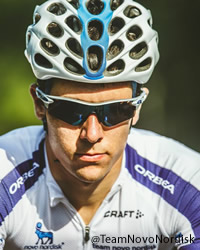
Team Novo Nordisk cyclist Stephen Clancy was diagnosed with type 1 diabetes at the age of 19, but now rides for the world’s first all-diabetes professional cycling team.
Clancy was observed to have abnormally high blood sugar levels during a training camp, and following his diagnosis, was told by his diabetes consultant that his diabetes management could be affected by extreme levels of exercise.
Speaking exclusively to Diabetes.co.uk, Clancy said: “The first thing I thought about when I was diagnosed was whether or not I could still have a career in the sport.
“Despite being an endurance sport, I was advised just to cycle a mile at a time, so I certainly wasn’t too optimistic about my future on two wheels.”
Diabetes management
Clancy joined Team Novo Nordisk within six months of his diagnosis, and the former recipient of Cycling Ireland’s “Domestic Rider of the Year” award has persevered to forge a career for himself in cycling.
His training routines and race days are different since his diagnosis, but Clancy does not see his diabetes as a hurdle that stops him from performing at his best.
“Having diabetes just means I now have one extra thing I have to think about while racing. It’s certainly not impossible. I like to see these changes as challenges that can be overcome rather than barriers.”
Clancy does, however, have to remain vigilant and alert to monitor his diabetes, and make sure all aspects of his management are controlled.
“I always need to be prepared. Whether on the bike or off the bike, I need to ensure I have all the necessary supplies with me at all times.
“Keeping my blood glucose levels in the optimum zone is one of the biggest tasks. This means checking my blood glucose regularly and making adjustments to ensure I stay within the target range.
“I also diligently watching what I eat, closely counting carbohydrate intake, monitoring activity levels and predicting blood glucose level trends along with taking my insulin.”
- For more information on managing your diabetes when cycling, click here
Medication routines
With each day different, Clancy finds it more practical to adapt his medication routines rather than stick to one specific plan.
“I don’t have one set medication routine that I stick to because every day changes slightly. I’ve realised that everyone is different and no two days are exactly the samen, which influences how I manage my diabetes.
“Initially, I thought I could get advice from people in the same situation to figure out what works and stick to that.”
Dietary changes
Professional athletes require strict dietary plans, but regulating blood sugar levels is an extra consideration for Clancy, who has experimented with dietary changes during his career.
“It’s shocking in hindsight, but I actually stopped eating fruit completely after my diagnosis because I was told there was sugar in fruit and that it wouldn’t be good for me.
“I thought I would be stuck eating just three times a day with a fixed amount of insulin and a set quantity of carbohydrates. However, I soon realised this was not the case.
“Seeing as I was already a cyclist, I had a healthy diet before my diagnosis, so I didn’t really need to change anything major.
“The main difference is that now I am more aware of what I am eating. I know exactly what I am putting into my body so that I can calculate what impact it will have.”
Being a diabetes ambassador
Clancy is a respected ambassador in the diabetes community, and believes that diabetes should not be used an excuse for not achieving something.
If you have dreams to be a sportsma, or in another career, and believe your diabetes may hold you back, Clancy advises that people use this challenge as motivation.
“I feel being an ambassador for diabetes is a huge part of the person I am today. I love being able to help improve the lives of other people by breaking down the barriers and showing what may be possible. It creates a purpose for each turn of the pedals.”
Clancy continues, “I believe it would be great to try and show more people that diabetes doesn’t have to hold you back. Instead of using diabetes as an excuse, use overcoming these challenges as motivation. Diabetes doesn’t have to hold you back from your dreams. First, you must manage your condition. It’s your body you are looking after, so if you treat it right and manage your diabetes, then it will reward you by performing at its best.”
- Read the full interview with Stephen Clancy.




